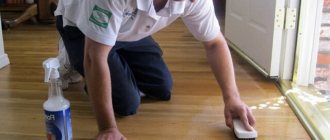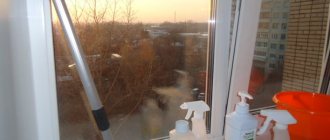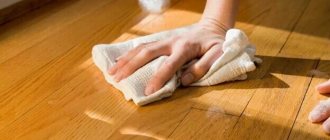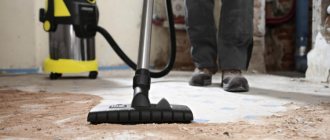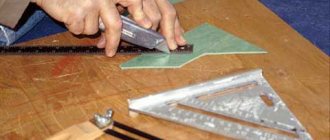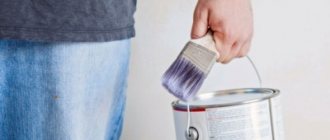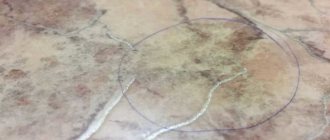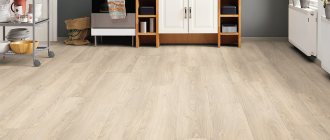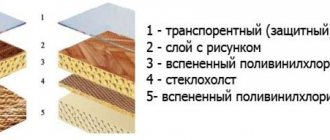Linoleum is a popular floor covering, practical and not very expensive. But during repairs, stubborn stains form on any material, even the highest quality ones. And we need to solve two problems at the same time - get rid of dirt and not spoil the appearance of the floor covering. For complete, high-quality cleaning, you can use both specialized and folk remedies. But there is a list of compounds that definitely cannot be used to clean the floor, since they can hopelessly ruin the appearance of linoleum. These are kerosene, gasoline, turpentine, ammonia, soda.
Cleaning linoleum after repair work
How to clean linoleum from polyurethane foam after repair
Fresh polyurethane foam must be carefully collected with a spatula or rag, removing the stain from the edges to the center. To completely remove its residues, you can use PENOSIL Foam Cleaner, ULTIMA Professional, OPPA. If the foam has dried, it is cut to the base with a sharp blade, and then the remainder is carefully “cut off.” In this case, you can use the pharmaceutical drug Dimexide as a cleaner, as well as the highly effective dissolving and cleaning aerosol product PENOSIL Premium Cured PU-Foam Remover, specially designed for this purpose.
Foam contamination
Primer
Such contamination also requires immediate action from the owners, since fresh stains can be easily removed with a soft cloth: the primer is collected, then the coating is washed. If you missed this step, you will have to deal with priming more seriously. Remove the top layer first, but scrape carefully so as not to affect the surface. After successful actions, begin scrubbing the stain with white spirit.
How can you remove paint from linoleum after repair?
The method and difficulty of removing paint depends on its type.
- Water-based paints used for walls and ceilings can be easily removed with a cloth moistened with water and household detergent.
- If oil paint has dripped onto the linoleum, it must be removed immediately, and a little vegetable oil, always refined, must be poured onto the remaining stain. Wait a while and then wipe the area with a napkin or rag.
- Traces of enamel or nitro enamel can only be removed with the help of solvents used for such paints. It can be solvent or white spirit. But before using them, you need to check in an inconspicuous area to see if the linoleum will lose color when applied.
To remove difficult paint stains, it is recommended to use multi-component universal solvent 646. However, when using it, you must follow safety rules - it is toxic and a fire hazard.
Ubiquitous paint
No matter how hard we try to paint as carefully as possible, the insidious thing still tries to stain the floor. In this severe case, only immediate removal will help, and delay will greatly complicate the task.
It must be said that each type of paint has its own saving recipes.
- Fresh “paint paint” may give way if you immediately apply vegetable oil to it to soften it. After waiting a few minutes, get to work - arm yourself with a rag or brush (not metal, but synthetic), and then carefully rub the stain. There is no need to apply any force, otherwise the surface may be damaged.
- Another option is solvent or any other product that contains alcohol. Just first you need to test it in an area well hidden from view. If no bad consequences are noticed, then apply a cotton wool soaked in solvent to the stain, hold it for several minutes, and then start scrubbing. It is advisable not to invade “healthy” areas.
- Stain is removed from linoleum using hydrogen peroxide or bleach. A few drops of one or another product will be required. After application, you need to pause and then wash the stained area with soapy water. With this method, even yellowed linoleum can be removed from the defect.
How and with what to clean linoleum after repair from whitewash and plaster
Warm water with soap and salt added to it helps to get rid of stains remaining after whitewashing and plastering simply and cheaply. For a glass of water you will need 3-4 teaspoons of salt. Hot water destroys the shine of the floor covering, so it is not used to wash linoleum.
A popular way to solve the problem is to add a small amount of kerosene to a bucket of water. After washing the floor with this mixture, an unpleasant odor remains in the room for a long time, so the room must be well ventilated. Washing the floor with water to which a small amount of vinegar is added will help remove the smell faster. Another way is to use the Mr. Proper product.
Consequences of repair work
If cement or lime mortar gets on the floor, the surface is first washed with warm water with the addition of a small amount of dishwashing detergent. For a bucket of water - a tablespoon of the product. Next, the linoleum must be washed with a saline solution - half a glass of table salt per 10 liters of water. If the contamination is strong, then 100 ml of 9% vinegar can be added to the salt solution.
How to care properly?
The surface of linoleum is quite capricious and sensitive, therefore it requires a sensitive attitude.
- Wet cleaning involves only warm water, since hot water can lead to unexpected consequences - peeling of the decorative layer.
- The sun's rays are also detrimental to linoleum - the coating fades.
- Any stains are removed immediately, otherwise the process will become much more complicated.
To avoid damaging the floor, special plates are placed under the furniture.
How can you clean linoleum after renovation without streaks?
After completing all repair and construction work, the linoleum must be washed so that there are no stains left on it from chalk dust, cement-sand mortar and other contaminants. For this purpose, potassium permanganate is used, a small amount of which is dissolved in warm water. The shade of the solution should be pale pink. Wash the floor, wait until it dries, and then rub it with a soft cloth lightly moistened with linseed oil. Milk diluted with water in a 1:1 ratio will help get rid of stains and restore the coating to its original shine.
To wash heavily soiled linoleum, it is recommended to use a solution of non-alkaline soap (you can take a regular bath soap) in warm water with the addition of a small amount of vodka. To refresh the appearance of the coating, you can wipe it with a cloth soaked in a solution consisting of 1 liter of water, a few drops of dish soap and 200 ml of vodka.
Removing contaminants after repair work
Taff Stuss is a very popular foam cleaner that allows you to carry out effective dry cleaning and get rid of dirt remaining after repairs.
Taboo for linoleum
This popular material, however, is quite capricious, and therefore requires careful handling. There is a list of products that under no circumstances can be used to clean it, otherwise you will quickly stop liking the floor. So, the following are contraindicated:
- any abrasives that leave scratches on the surface;
- undiluted bleaches;
- soda and alkali, which can lead to disruption of the very structure of linoleum;
- chemical solvents that can only be used locally and for small stains.
Removal of various building materials
This flooring suffers the most during renovations . Here you have to deal not with ordinary dirt, which can be removed with water and a rag, but with caustic building compounds that are difficult to clean. However, you can deal with them too. Let's look at the main types of problematic contaminants that arise during repairs, as well as how to get rid of them.
We recommend: Features of artificial stone fireplaces
Cement and whitewash
white stains
appear during floor washing , which are very difficult to get rid of.
The streaks disappear only after repeated washing . To speed up the procedure, you can use regular table salt .
You need to add a few teaspoons to a bucket of warm water and stir thoroughly. Then wash the floor with this mixture.
Also, such contaminants are perfectly removed by kerosene . A small amount of this liquid should be applied to a rag and wipe the floor with it. True, after using it, a characteristic smell remains. You can get rid of it by ventilating the room well and re-rinsing the linoleum with clean water.
Paint spots
If the paint has just hit the linoleum and has not yet had time to dry, it should be quickly removed with a rag. Solvent works well for dried paint stains . You can also remove paint by softening it with sunflower oil . This method is more gentle, because the coating is not exposed to chemical attack.
Polyurethane foam
If polyurethane foam gets on the floor covering, you need to act quickly.
Important! When working with polyurethane foam, it is better to prepare unnecessary rags in advance to remove residual foam from the floor.
As soon as foam gets on the floor, it should be removed immediately. Otherwise, it will harden and the removal process will become more difficult.
If the polyurethane foam has frozen, you need to carefully tear it off, using a spatula or knife . There will still be foam particles on the floor. To eliminate them, you will need to use a special composition that is used to clean polyurethane foam guns. It is sold in cylinders. This composition dilutes the foam, after which it can be easily removed.
Zelenka
Unfortunately, a stubborn stain of brilliant green cannot be removed by any means .
But if this substance just got on the floor, then there is a chance.
We recommend: Purchasing gardening equipment and garden equipment
You must immediately wipe the contaminated area with cotton wool or a sponge moistened with ammonia .
Acetone will also work . After removing the stain, wash the surface with warm water.
Facilities
In order to wipe off various contaminants from the surface of linoleum and, if possible, return it to its original appearance, you can use both chemical and folk remedies. Both of them deserve special attention, because thanks to them you can refuse to purchase a new coating, thereby saving significant money.
Folk
There are many folk remedies available to everyone without exception. Their high efficiency has been proven and time-tested more than once. Each product is usually used for a specific type of contamination and consists of one or two components.
In order to return linoleum, which has been lying on the floor for many years, to its original shine, you should use milk and water. To do this, you need to mix equal parts of both components and treat the floor surface with this solution. Allow the floor to dry for some time and then rub the surface with a small piece of cloth containing wool fibers. The best effect can be achieved if you use 100% wool.
Very often, stripes form on the surface of linoleum. Most often, their occurrence is associated with traces of shoe soles. Most of these stripes form in the corridor. To remove them, you can use an ordinary school eraser. All you have to do is rub a little and the stripes disappear. Then you can wash the floor as usual.
Traces from a regular ballpoint pen can be easily wiped off using regular sulfur . It is easy to find sulfur; it is present in matches. First you need to wet the head of the match, and then rub it on the place where there are traces of the handle. The resulting paste is removed using a piece of lint-free cloth.
Potato starch helps prevent iodine stains. A paste-like mixture of starch and water is applied to the stained area. You need to keep the composition until the stain completely disappears from the surface of the linoleum. You can get rid of stubborn greasy stains with the help of elderberries.
